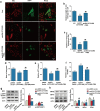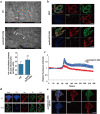ApoE4 (Δ272-299) induces mitochondrial-associated membrane formation and mitochondrial impairment by enhancing GRP75-modulated mitochondrial calcium overload in neuron
- PMID: 33676568
- PMCID: PMC7937300
- DOI: 10.1186/s13578-021-00563-y
ApoE4 (Δ272-299) induces mitochondrial-associated membrane formation and mitochondrial impairment by enhancing GRP75-modulated mitochondrial calcium overload in neuron
Abstract
Background: Apolipoprotein E4 (apoE4) is a major genetic risk factor of Alzheimer's disease. Its C-terminal-truncated apoE4 (Δ272-299) has neurotoxicity by affecting mitochondrial respiratory function. However, the molecular mechanism(s) underlying the action of apoE4 (Δ272-299) in mitochondrial function remain poorly understood.
Methods: The impact of neuronal apoE4 (Δ272-299) expression on ER stress, mitochondrial-associated membrane (MAM) formation, GRP75, calcium transport and mitochondrial impairment was determined in vivo and in vitro. Furthermore, the importance of ER stress or GRP75 activity in the apoE4 (Δ272-299)-promoted mitochondrial dysfunction in neuron was investigated.
Results: Neuronal apoE4 (Δ272-299) expression induced mitochondrial impairment by inducing ER stress and mitochondrial-associated membrane (MAM) formation in vivo and in vitro. Furthermore, apoE4 (Δ272-299) expression promoted GRP75 expression, mitochondrial dysfunction and calcium transport into the mitochondria in neuron, which were significantly mitigated by treatment with PBA (an inhibitor of ER stress), MKT077 (a specific GRP75 inhibitor) or GRP75 silencing.
Conclusions: ApoE4 (Δ272-299) significantly impaired neuron mitochondrial function by triggering ER stress, up-regulating GRP75 expression to increase MAM formation, and mitochondrial calcium overload. Our findings may provide new insights into the neurotoxicity of apoE4 (Δ272-299) against mitochondrial function and uncover new therapeutic targets for the intervention of Alzheimer's disease.
Keywords: Alzheimer’s disease; Apolipoprotein E4; ER stress; Mitochondrial Ca2+ overload; Mitochondria‐associated ER membrane; apoE4 (Δ272–299).
Conflict of interest statement
The authors declare no competing interests.
Figures






Similar articles
-
Neuron-Specific Apolipoprotein E4 (1-272) Fragment Induces Tau Hyperphosphorylation and Axonopathy via Triggering Endoplasmic Reticulum Stress.J Alzheimers Dis. 2019;71(2):597-611. doi: 10.3233/JAD-190419. J Alzheimers Dis. 2019. PMID: 31424401
-
GRP75-faciliated Mitochondria-associated ER Membrane (MAM) Integrity controls Cisplatin-resistance in Ovarian Cancer Patients.Int J Biol Sci. 2022 Apr 11;18(7):2914-2931. doi: 10.7150/ijbs.71571. eCollection 2022. Int J Biol Sci. 2022. PMID: 35541901 Free PMC article.
-
Glucose-regulated protein 75 determines ER-mitochondrial coupling and sensitivity to oxidative stress in neuronal cells.Cell Death Discov. 2017 Nov 6;3:17076. doi: 10.1038/cddiscovery.2017.76. eCollection 2017. Cell Death Discov. 2017. PMID: 29367884 Free PMC article.
-
Apoe4 and Alzheimer's Disease Pathogenesis-Mitochondrial Deregulation and Targeted Therapeutic Strategies.Int J Mol Sci. 2023 Jan 1;24(1):778. doi: 10.3390/ijms24010778. Int J Mol Sci. 2023. PMID: 36614219 Free PMC article. Review.
-
A Review of the Role of Endo/Sarcoplasmic Reticulum-Mitochondria Ca2+ Transport in Diseases and Skeletal Muscle Function.Int J Environ Res Public Health. 2021 Apr 7;18(8):3874. doi: 10.3390/ijerph18083874. Int J Environ Res Public Health. 2021. PMID: 33917091 Free PMC article. Review.
Cited by
-
Mitochondria in Alzheimer's Disease Pathogenesis.Life (Basel). 2024 Jan 30;14(2):196. doi: 10.3390/life14020196. Life (Basel). 2024. PMID: 38398707 Free PMC article. Review.
-
Lipoprotein Metabolism, Protein Aggregation, and Alzheimer's Disease: A Literature Review.Int J Mol Sci. 2023 Feb 2;24(3):2944. doi: 10.3390/ijms24032944. Int J Mol Sci. 2023. PMID: 36769268 Free PMC article. Review.
-
APOE ε4 allele, along with G206D-PSEN1 mutation, alters mitochondrial networks and their degradation in Alzheimer's disease.Front Aging Neurosci. 2023 Jun 29;15:1087072. doi: 10.3389/fnagi.2023.1087072. eCollection 2023. Front Aging Neurosci. 2023. PMID: 37455931 Free PMC article.
-
Dysregulation of cellular membrane homeostasis as a crucial modulator of cancer risk.FEBS J. 2024 Apr;291(7):1299-1352. doi: 10.1111/febs.16665. Epub 2022 Nov 7. FEBS J. 2024. PMID: 36282100 Free PMC article. Review.
-
Functional diversity of apolipoprotein E: from subcellular localization to mitochondrial function.Cell Mol Life Sci. 2022 Aug 26;79(9):499. doi: 10.1007/s00018-022-04516-7. Cell Mol Life Sci. 2022. PMID: 36018414 Free PMC article. Review.
References
-
- Tesseur I, Van Dorpe J, Bruynseels K, Bronfman F, Sciot R, Van Lommel A, Van Leuven F. Prominent axonopathy and disruption of axonal transport in transgenic mice expressing human apolipoprotein E4 in neurons of brain and spinal cord. Am J Pathol. 2000;157:1495–510. doi: 10.1016/S0002-9440(10)64788-8. - DOI - PMC - PubMed
Grants and funding
LinkOut - more resources
Full Text Sources
Other Literature Sources
Miscellaneous

